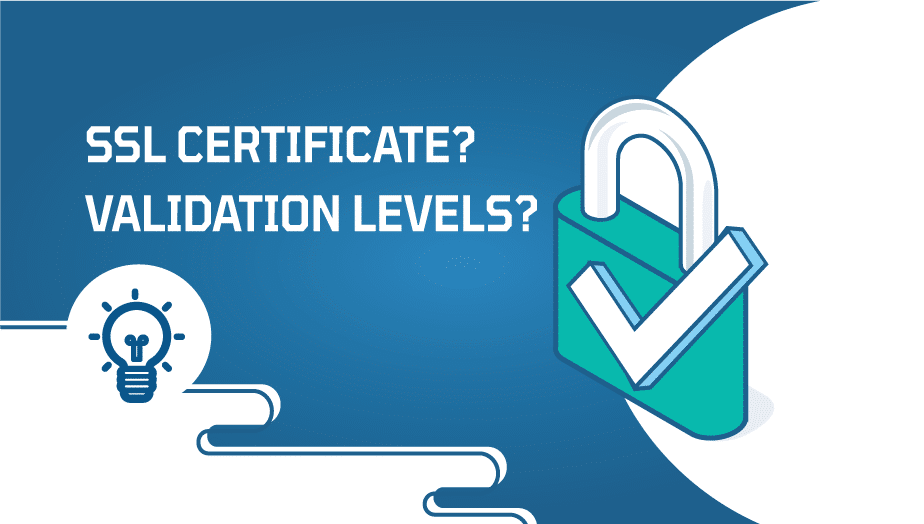SSL certificates and different validation levels
A SSL certificate on your web server is a piece of code protecting online communication. The SSL certificate enables an encrypted connection when a web browser visits your secure website. In a sense, this is similar to sealing a letter inside an envelope before sending it through the mail.
In this article you will learn about different validation levels and certificate types of SSL.
Let’s get started,
How does an SSL certificate work?
HTTPS encryption on a website requires SSL certificates (also known as TLS certificates). The certificate contains information about a website’s public key, its domain name, the digital signature of the certificate authority that issued it, as well as other important details. By verifying an origin server’s identity, on-path attacks and domain spoofing can be prevented.
Before you can receive a certificate, you need to generate a Certificate Signing Request (CSR). This process creates on your server a public and a private key. SSL Certificate issuers (also called Certificate Authorities) receive the public keys as part of the CSR files. CAs use CSR data files to create matching data structures without compromising private keys. CAs never see private keys.
What are the different types of SSL certificates?
In the market, three kinds of certificates are available,
1. Single Domain SSL Certificates
Single-domain SSL certificates can only include one domain. It cannot be authenticated with any other domain, including subdomains of the domain it’s associated with. Using a single-domain certificate, all pages on the domain are protected.
For example, VPSie.com would have a single-domain certificate which would also cover VPSie.com/help (the main page for support).
2. Wildcard SSL Certificates
An SSL Wildcard certificate covers one domain and all of its subdomains. Subdomains are part of the main domain. It’s common for subdomains to have an address that starts with something other than ‘www.’ Among the subdomains of www.vpsie.com are support.vpsie.com, community.vpsie.com, and meet.vpsie.com. Each is a subdomain of vpsie.com.
A Wildcard SSL certificate can cover all of these subdomains. All subdomains will be covered by an SSL certificate. By clicking the padlock in their browser’s address bar, they can view the subdomains covered by the certificate, then click on “Certificate” to view its details.
3. Multi-Domain SSL Certificates (MDC)
A multi-domain SSL certificate is one that covers multiple domains with the same IP address. When it comes to encryption strength, SAN or UCC multi-domain certificates employ the same encryption methods used by other solutions provided by trusted third-party certificates authorities (CAs). Between the two extensions, there is only one difference. It is the addition of additional domains.
Those domain names which have the base domain appear in the common names section. It works with 99.9% of all web browsers and handles all validation levels – domain validation (DV), organization validation (OV), and extended validation (EV). With a single SAN SSL certificate, you can secure up to 250 domains, subdomains, IP addresses, hostnames, or external locations. By using larger certificates with more SANs, page load speeds may be affected.
What are the different validation methods?
There are a few differences in the types of validation offered by SSL certificates. As an example:
- DV (Domain validation)
- OV (Organization validation)
- EV (Extended validation)
Each certificate requires a different level of authentication in order to be issued, but both provide the same level of encryption protection. Validation is the process by which a certificate is verified by a Certificate Authority. Verification is necessary to ensure the site that is to receive the certificate is authorized to use it.
1. Domain validation
Certificates for these services are validated solely by their domain names. Therefore, the name of your website is not visible when you view the certificate. Either certificate can be added by any administrator with access to the website’s control panel. Once added, the certificate is automatically added to the panel.
Certificates for smaller sites without sensitive information exchanges are recommended.
2. Organizational validation
These confirm that the purchaser of a certificate includes his or her name, city, state, and the country as well as all the other things a (DV) requires. There’s also a name of the organization on the certificate. In this way, visitors can verify the legitimacy of a company and website, which will increase trust.
For (OV) certificates, users may be asked to respond to an email with a verification code. It depends on how DCV verifies the certificate, though.
3. Extended validation certificates
Since they require the most validation to be issued, EV certificates are the most trusted by visitors.
The URL bar in the browser will display a green color when you visit their website. The site visitor can see here the maximum amount of steps that have been taken to confirm they are visiting the right site.
ebay.com is an example of such a site.
Hopefully you now understand the basic SSL certificate types and method of validation.
That’s it
Get the most out of learning with VPSie.com





















